JCVI La Jolla: Sustainable Laboratory Facility
A Seamless Integration of Scientific Vision, Purpose and Technology
JCVI’s commitment to environmental stewardship inspired the design and construction of our West Coast home: a unique, LEED Platinum biological laboratory building that generates almost all of the energy it consumes from the solar panels on its roof.
Located on the campus of the UC San Diego, JCVI La Jolla contains some of the most innovative water and energy-efficient systems available, and, most importantly, is serving as a model for sustainable research buildings worldwide.

JCVI La Jolla
Project Data
OWNER
J. Craig Venter Institute
ARCHITECT / INTERIOR DESIGNER
ZGF Architects LLP
GENERAL CONTRACTOR
McCarthy Building Companies, Inc.
M/E/P ENGINEER
Integral Group and Peter Rumsey PE
LIGHTING DESIGNER
David Nelson & Associates
STRUCTURAL AND CIVIL ENGINEER
KPFF Consulting Engineers
LABORATORY PLANNER
Jacobs Consultancy
LANDSCAPE ARCHITECT
Andropogon Associate with
David Reed, Landscape Architects
BUILDING CONTROLSSC Engineers, Inc.
CONSTRUCTION MANAGEMENT
Sustainable SoCal, Inc.
PHOTOGRAPHERS
Nick Merrick © Hedrich Blessing
Tim Griffith © Tim Griffith
BOOKLET DESIGN
ZGF Architects LLP
Sustainability — Pushing the Boundaries of Energy Efficient Design
As one of the greenest buildings in the country, the new facility is designed to achieve LEED-Platinum certification with a near net-zero energy footprint. Two arrays, comprising 26,124 SF of photovoltaic surface across 1,488 Sunpower E20 / 327 panels, were designed to meet the building demand over the timeframe of a year—the first biological laboratory in the world to attempt this.
Building occupants are responsible for reducing plug loads by 31% to achieve this goal. In terms of light energy, sensors detect when artificial lighting is required, but variable brightness settings ensure that no more lighting is provided than required.
Instead of using air-cooling, the laboratory freezers use a more efficient water-cooled system that consumes less energy. Induction diffusers (active chilled beams) deliver minimum air change rates to meet Environmental Health & Safety requirements for laboratories and offices, but they also have a heating / cooling coil that delivers either hot water or cool water to heat or cool the building, eliminating any re-heating of the air supply.
Virtually all site rainwater and air handler condensate is collected into three interconnected cisterns, and then UV-filtered and recycled for non-potable water functions within the building, which is expected to reduce the building’s domestic water demand by 70 percent. Native low-water landscaping and terrace gardens help collect rainwater and keep the building naturally cooler.

HVAC Systems
Cooling
Thermal Storage Tank Charging
1 The cooling tower (open loop system) generates cool water at night, which is supplied to the heat exchanger. 2 Heat from the building is carried back to the cooling tower through the heat exchanger. 3 Cool water (closed loop system) from the heat exchanger is used to charge the thermal storage tanks. 4 If tank temperature is not satisfied in the early morning (typically, only during hot summer periods), chiller can be used to charge the thermal storage tanks. 5 Heat from chiller operation is carried back to the cooling tower.
Thermal Storage Tank Discharging
6 During the day, cool water is drawn off the cool side of the thermal storage tanks for use in cooling the building by supplying the air handlers and induction diffusers. 7 Heat removed from the building is returned to the warm side of the thermal storage tanks.
This allows for cooling of the building during the winter months and most of the shoulder months of the year with minimal operation of the chiller.
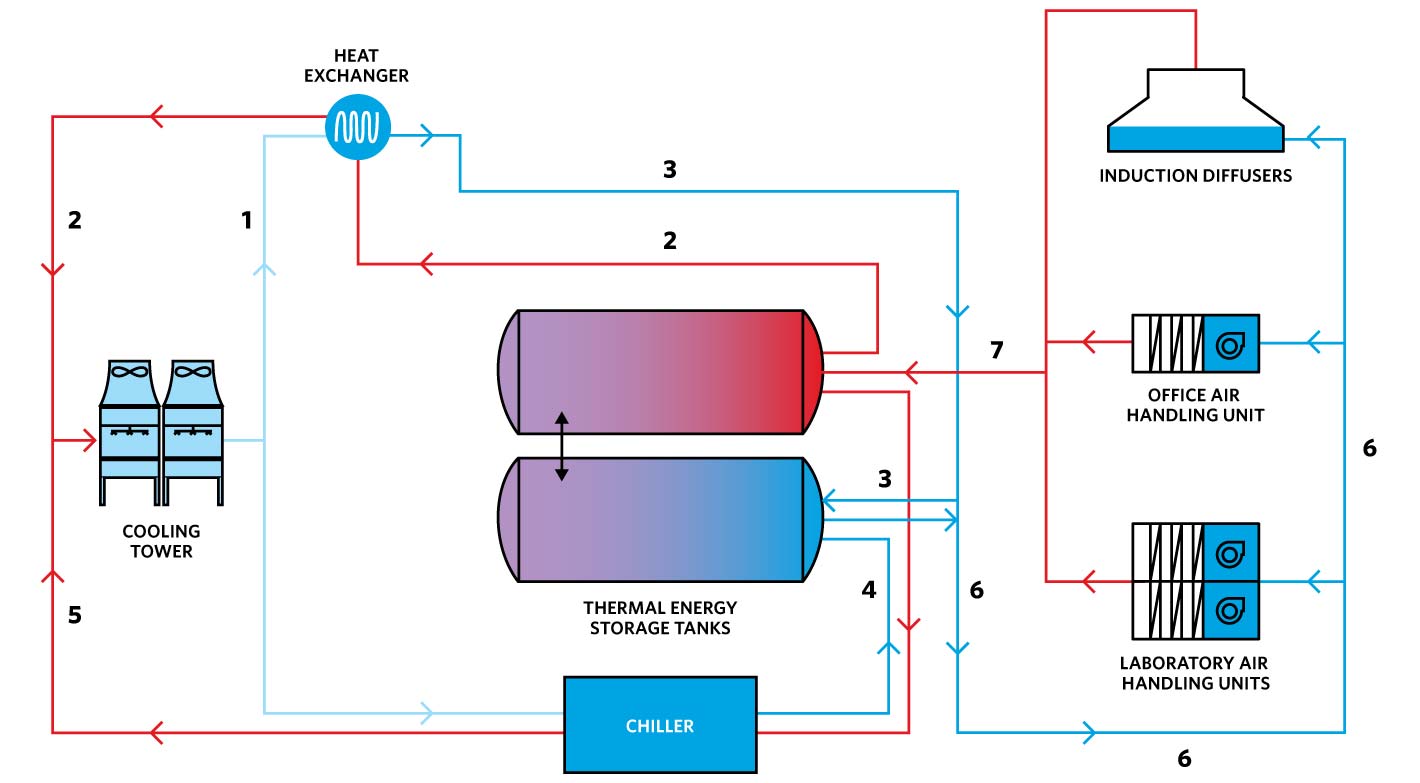
Heating
1 Warm water from the thermal energy storage tank goes to the heat pump to provide heating. 2 Heated hot water goes to the air handling units and the induction diffusers and provides a heat source for domestic and industrial water systems. 3 Cold water by-product from the heat pump goes back to the cold side of the thermal energy storage tank. 4 Cold water by-product from the induction diffusers and the air handling units go back to the heat pump to be reheated.
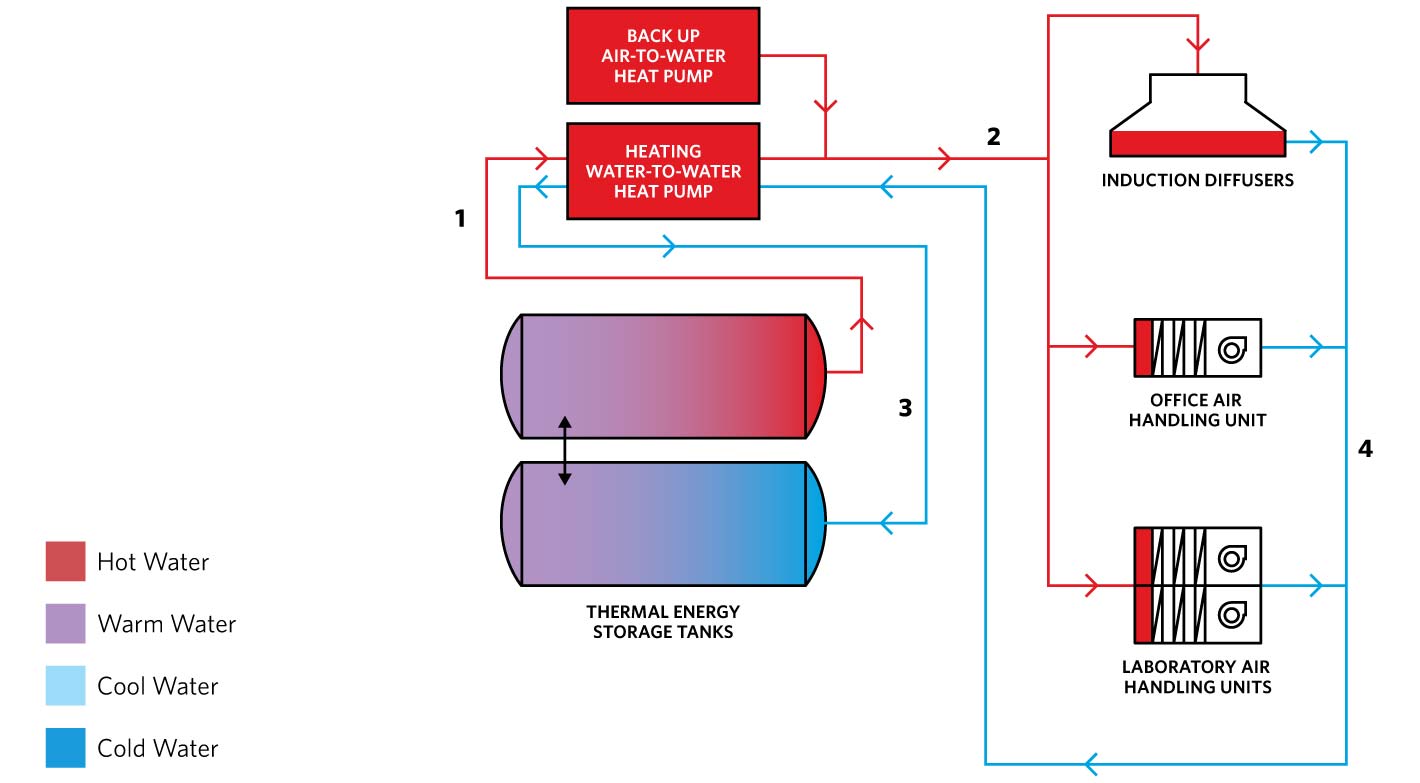
Variable Laboratory Air Changes
Reducing energy is only one feature of the JCVI mechanical system. Through the use of induction diffusers and an air monitoring system, laboratories are provided with 4 to 6 air changes when spaces are occupied, with the capacity to “ramp up” individual laboratories in the event of a spill. The minimum is 2 air changes for unoccupied times. In addition to energy savings and laboratory safety, the laboratories are quieter and more comfortable for the occupants than traditional laboratory HVAC systems.
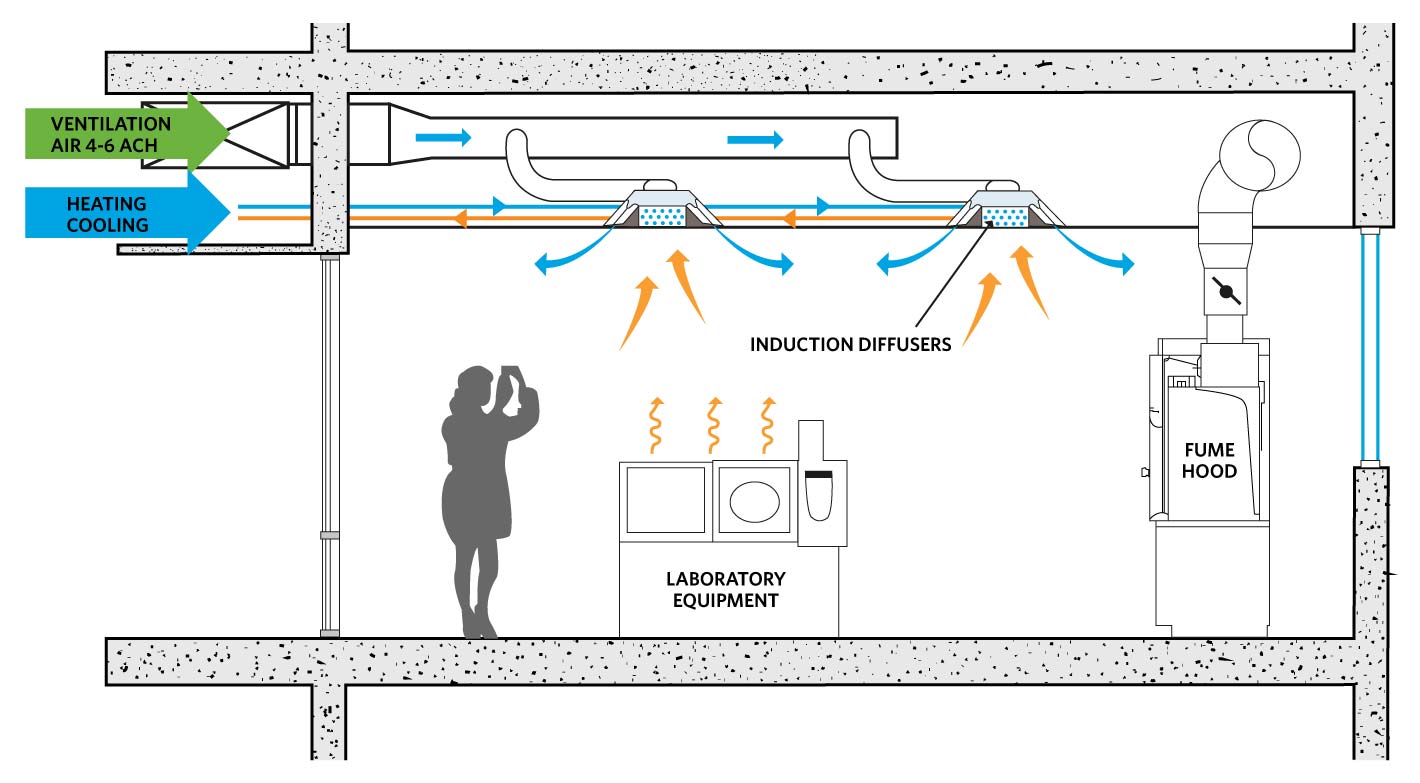
Building Intelligence
The building systems were tied together through a unique intelligent building interface. With this the operations team can troubleshoot and optimize the building with a single user-friendly interface.
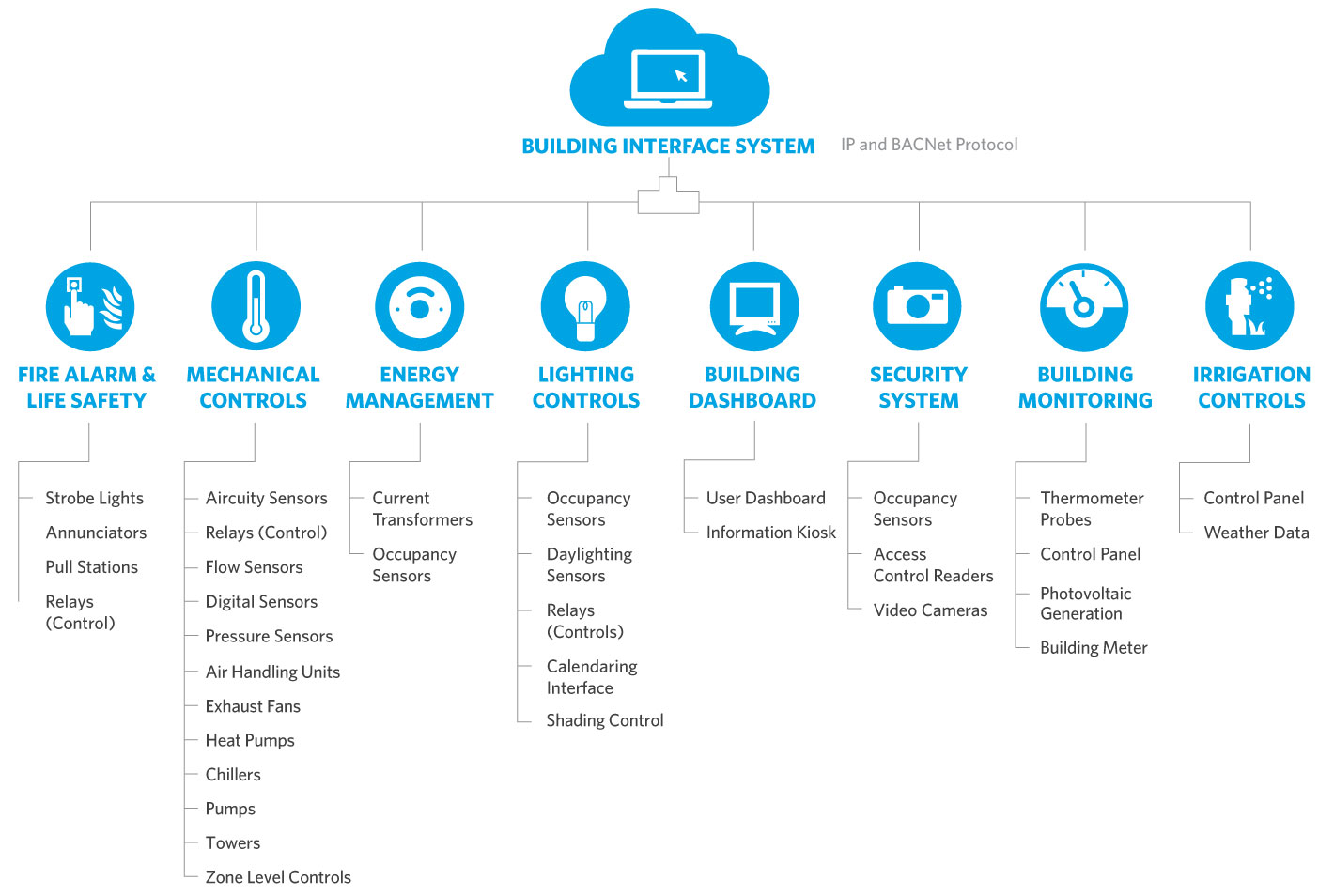
Water Conservation
A complex water-balancing model was developed to understand the quantities, frequency, and demand times of water use. The result is a system that uses rain and recycled water, when available, for everything except potable water uses. Plans for a greywater connection to the building (purple pipe) have also been established to allow for use of reclaimed water in the future.
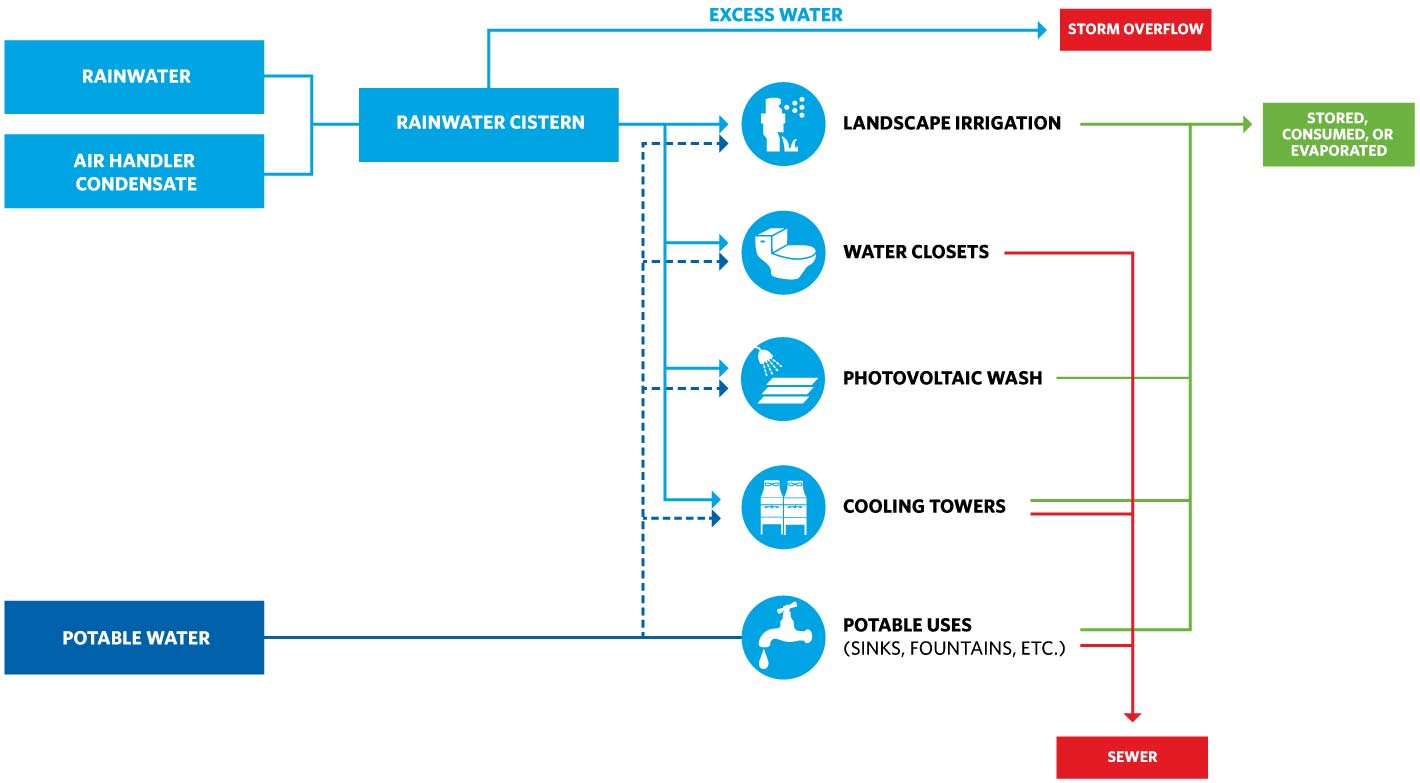

JCVI La Jolla
Project Data
OWNER
J. Craig Venter Institute
ARCHITECT / INTERIOR DESIGNER
ZGF Architects LLP
GENERAL CONTRACTOR
McCarthy Building Companies, Inc.
M/E/P ENGINEER
Integral Group and Peter Rumsey PE
LIGHTING DESIGNER
David Nelson & Associates
STRUCTURAL AND CIVIL ENGINEER
KPFF Consulting Engineers
LABORATORY PLANNER
Jacobs Consultancy
LANDSCAPE ARCHITECT
Andropogon Associate with
David Reed, Landscape Architects
BUILDING CONTROLSSC Engineers, Inc.
CONSTRUCTION MANAGEMENT
Sustainable SoCal, Inc.
PHOTOGRAPHERS
Nick Merrick © Hedrich Blessing
Tim Griffith © Tim Griffith
BOOKLET DESIGN
ZGF Architects LLP
Videos
Pursuing a Net-Zero Energy Laboratory
San Diego Green Building Council Education Series
Project Intent
Design
Water Efficiency & Diagram Explanations
Measurement, Plug Loads and Freezers
HVAC Cooling & Heating Diagram Explanation
Materials
Chilled Beams & Laboratory Air Flow
Office Ventilation & Occupant Participation
See the entrire USGBC series.
JCVI La Jolla Construction Time-Lapse

JCVI La Jolla
Project Data
OWNER
J. Craig Venter Institute
ARCHITECT / INTERIOR DESIGNER
ZGF Architects LLP
GENERAL CONTRACTOR
McCarthy Building Companies, Inc.
M/E/P ENGINEER
Integral Group and Peter Rumsey PE
LIGHTING DESIGNER
David Nelson & Associates
STRUCTURAL AND CIVIL ENGINEER
KPFF Consulting Engineers
LABORATORY PLANNER
Jacobs Consultancy
LANDSCAPE ARCHITECT
Andropogon Associate with
David Reed, Landscape Architects
BUILDING CONTROLSSC Engineers, Inc.
CONSTRUCTION MANAGEMENT
Sustainable SoCal, Inc.
PHOTOGRAPHERS
Nick Merrick © Hedrich Blessing
Tim Griffith © Tim Griffith
BOOKLET DESIGN
ZGF Architects LLP

JCVI La Jolla
Project Data
OWNER
J. Craig Venter Institute
ARCHITECT / INTERIOR DESIGNER
ZGF Architects LLP
GENERAL CONTRACTOR
McCarthy Building Companies, Inc.
M/E/P ENGINEER
Integral Group and Peter Rumsey PE
LIGHTING DESIGNER
David Nelson & Associates
STRUCTURAL AND CIVIL ENGINEER
KPFF Consulting Engineers
LABORATORY PLANNER
Jacobs Consultancy
LANDSCAPE ARCHITECT
Andropogon Associate with
David Reed, Landscape Architects
BUILDING CONTROLSSC Engineers, Inc.
CONSTRUCTION MANAGEMENT
Sustainable SoCal, Inc.
PHOTOGRAPHERS
Nick Merrick © Hedrich Blessing
Tim Griffith © Tim Griffith
BOOKLET DESIGN
ZGF Architects LLP